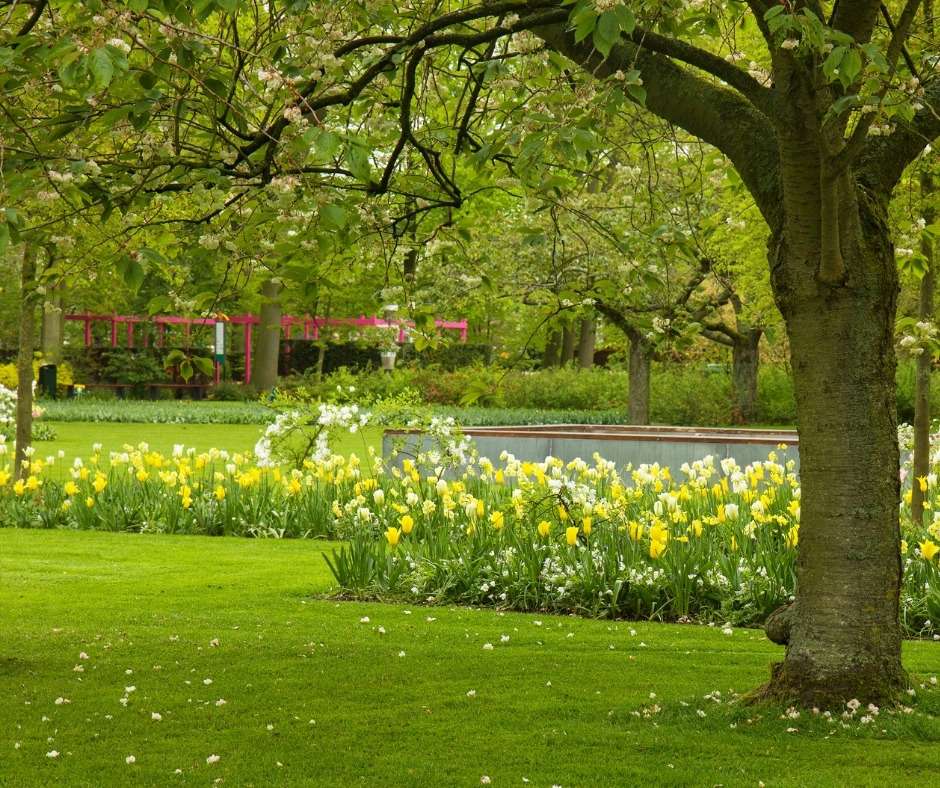Spring lawn care starts now. Literally.
If spring was around the corner a few weeks ago, guess what? Spring is now, and you have to get moving.
For any turf lover, spring lawn care is not part of a long and forceful honey-do list.
It is quite the opposite.
It is a pleasure.
Think about it.
You are going to spend some time outside, breathing the fresh air, reconnecting with Mother Earth. You will have that feeling of accomplishing something selfless that your family will love and that will exhilarate your sense of pride.
That’s what spring lawn care is, in essence. It brings back a smile on your face.
Of course, spring lawn care starts when the temperature gets somewhat warmer. Then, it’s time to get your rake, your blower, and get moving.
Spring Lawn Care Starts Here.
Spring lawn care is like a work of art. Before getting started, there is some preparation to do.
And the first thing to prepare is the canvas. Therefore, remove the branches, leaves, and rake your lawn surface.
Removing debris and thatch is very important.
Thatch is a layer of dead organic materials. Thatch build-up begins when your lawn produces organic debris faster than it can break it down.
A build-up of thatch over 1″ can increase pest problems and diseases. So, it is good to remove that layer periodically. You do not want that layer to be over 1”.
How About Lawn Aeration?
Have you built a snowman during the winter or got involved in an epic snowball fight with the family? Have you played ball with the kids and dog on your lawn?
If it is the case, you may consider addressing your soil compaction, and you may want lawn aeration.
Grassroots need air, water, and nutrients to grow thick and strong. Your turf is a living thing, and like any living thing, it needs water, air, and food.
Compaction prevents the penetration of these essential elements in the soil. Even slight compaction can impact the health and beauty of your lawn.
There are two ways to aerate lawns either core aeration or liquid aeration.
Beyond a technical difference, lawn aeration is recommended once per year or every other year.
It depends on the intensity of the activity on your lawn.
Lawn aeration is a simple process that will benefit your lawn. Most homeowners or property managers do not know this process’s actual effects & benefits because most of the big national brands do not want to mess with it.
Know Your Soil in Chester County, PA
You are now ready to fertilize.
Well, not quite.
So, let us step back here and say that you are almost ready to fertilize.
Of course, how could you possibly prepare your fertilizer without knowing the needs of your soil?
It’s impossible and even potentially harmful to your lawn.
Lawn fertilization is a science to feed a plant with different stuff for that plant to thrive.
First thing first, get a sample of your soil and send it to a third-party lab, and wait for the results.
Your lawn needs three things: Potassium, phosphorus, and nitrogen.
Nitrogen or “N” is the secret of your green color. Nitrogen promotes the production of chlorophyll that is essential for photosynthesis.
But, you need to know how much nitrogen, potassium, and phosphorus you need to spray over the surface of your yard.
To determine that, you need to know what your turf needs. Therefore, a soil analysis is essential to decide on the nutritional elements required. So, pick up a test kit.
The results you receive back from the lab are fascinating and will inform you of what is going on with your land piece.
Once you know and identify the nutritional deficiencies, you are ready to prepare your fertilizer and get moving.
Your Takeaways!
After some conscious winterization, spring lawn care will revive your lawn. It is also a process, and you need to know the essential steps for having a thriving lawn that you will love.
Here are the steps:
- Clean your yard, remove debris, and address thatch.
- Aerate your lawn in case you had any activity on it during the fall and winter.
- Take a sample of your soil and send it to a lab to understand what your lawn needs.
- Based on the lab results, prepare your lawn fertilizer.
As always, if you have more questions about spring lawn care or any other topic concerning your lawn, connect with us! We try our best to respond to all of them.
In the meantime, enjoy the spring with your family and stay safe.

